Different types of packaging for the same beverage can have very different impacts on the…
The post How To Use Life Cycle Assessments To Choose Responsible Beverage Products appeared first on Earth911.

Different types of packaging for the same beverage can have very different impacts on the…
The post How To Use Life Cycle Assessments To Choose Responsible Beverage Products appeared first on Earth911.
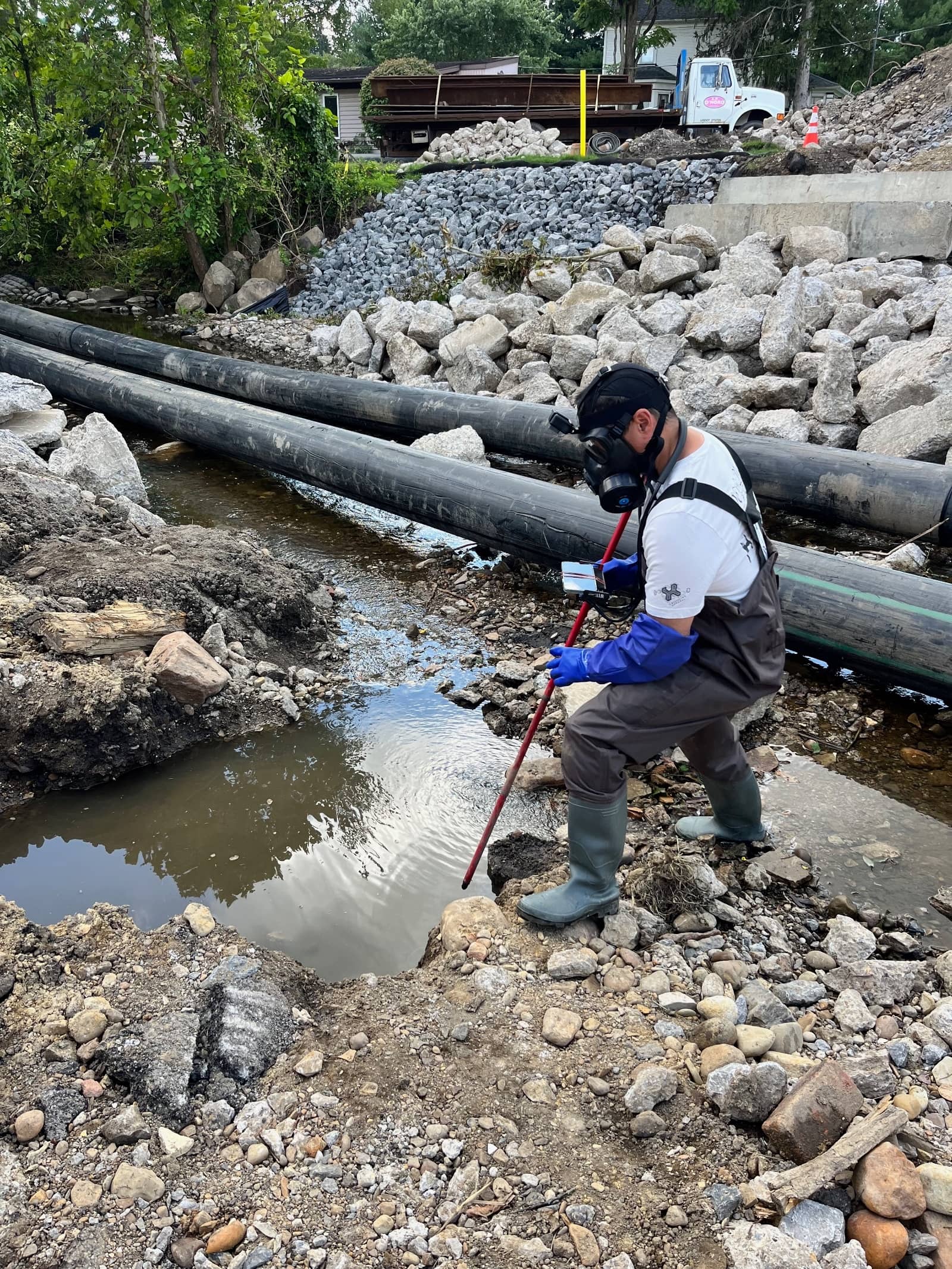
If there hadn’t been construction planned for the bridge that crosses over Leslie Run, one of the creeks that runs through the middle of East Palestine, Ohio, Rick Tsai and Randy DeHaven might not have noticed the worst contamination they’d seen in the creek in weeks.
A backhoe had hoisted a chunk of earth from the bank of the creek, leaving a pool about eight feet across and deep enough to come up to the knees of Tsai’s rubber fishing waders. What it also left, in Tsai’s words, was an opportunity for a sort of “geological sample” — evidence that oil and chemicals still lingered in the soil and in the creeks six months after a catastrophic derailment.
On February 3, 2023, a Norfolk Southern train carrying thousands of gallons of toxic chemicals derailed and spilled its contents in the town of East Palestine, on the Pennsylvania border. Three days later, in an effort to prevent a dangerous explosion, Norfolk Southern supervised a controlled vent-and-burn of hazardous vinyl chloride, which produced a toxic cloud that spread for miles over the surrounding area.
On a late August morning, Tsai asked me to stand on the freshly created edge of the pool, while he shook some dirt and rocks loose from the bank with a metal rod. As they tumbled into the water, an iridescent web spooled out across the water’s surface, emanating from the point Tsai had disturbed. He exclaimed into his respirator, declared the water as bad as he’d ever seen, and gestured for me to lean down and look closer. The simple fact of my body’s weight on the creek bank elicited a new burst of oily sheen, billowing into the still pool.
“It looked like ‘Starry Night,’” Tsai, referring to the Vincent van Gogh painting, later described to a few community members gathered in the lobby of his chiropractic office. “It would be beautiful if it weren’t so toxic and deadly.”

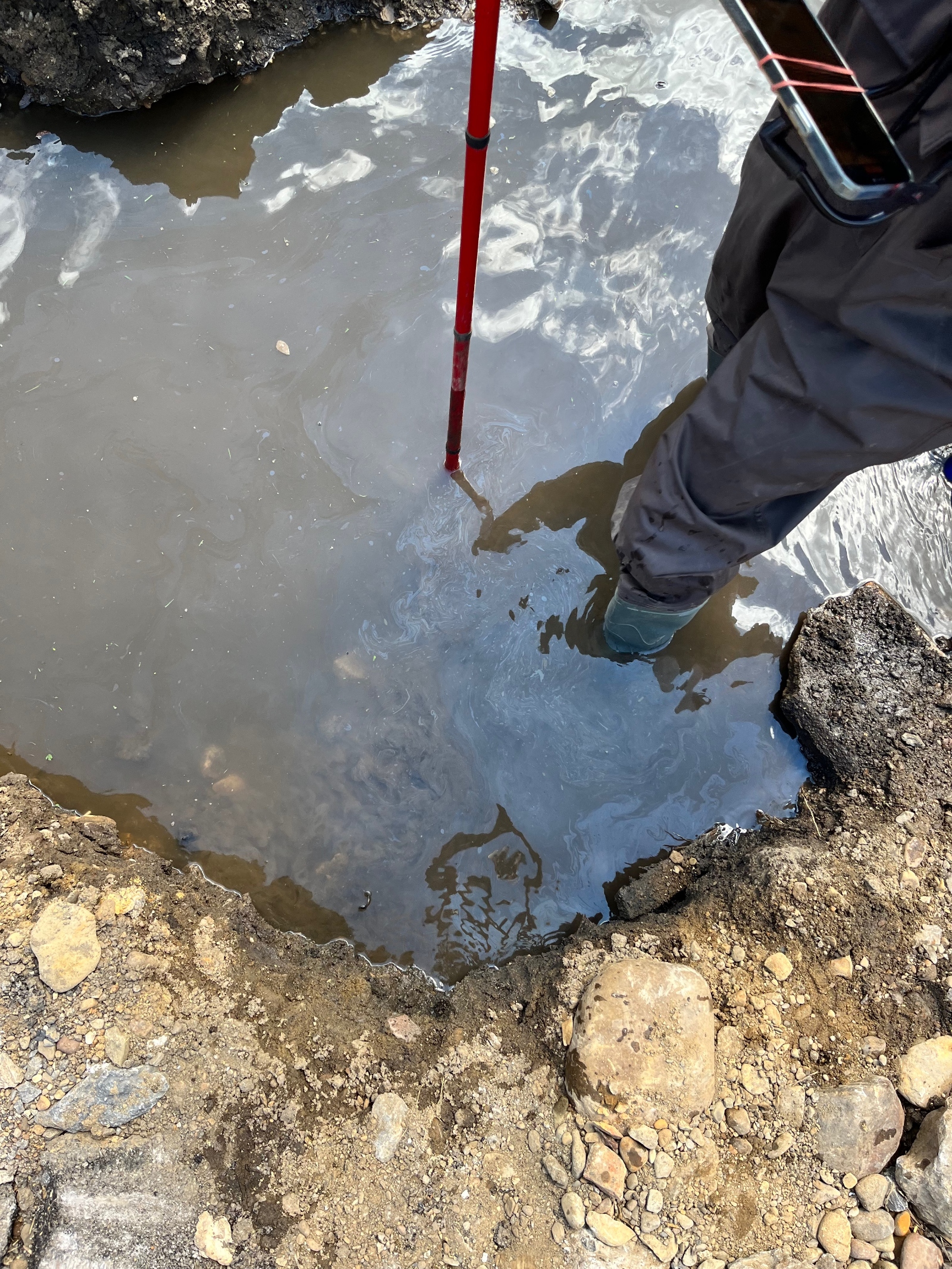
Rick Tsai searches for evidence of lasting pollution in the creek water at a construction site at Leslie Run. With a metal rod, he disturbs the oily sheen on the creek’s surface. Grist/ Eve Andrews
As the one-year anniversary of the derailment approaches, Tsai, DeHaven, and many other residents across East Palestine and its surrounding towns have not accepted federal regulators’ assurance that the water, air, and soil are safe for its residents. In rubber boots and waders, smartphones strapped to their chests to document the pollution, they wield shovels and rods to dislodge rocks and earth that harbor reserves of substances persistently leaching into the creeks. By DeHaven’s estimate, he spends as many as 15 hours a week wading through the waterways.
At the beginning of August, when construction on the bridge began, DeHaven found a pool that had been dammed off in Leslie Run, thick with oil that carried a chemical stink. Dead fish littered the bottom of the creek. That week, Tsai took a water sample from Sulphur Run, upstream of its juncture with Leslie Run, using a kit approved by the U.S. Environmental Protection Agency. He sent it to a Eurofins lab in Cleveland to test for the presence of volatile organic compounds, or VOCs.
I asked Tsai, when I met him at the construction site, how he knew the substance pouring out of the bank was more than oil. He told me that it was how he felt, physically, when he spent time in the creek without a gas mask: burning nostrils, faintness, acid reflux, diarrhea. He showed me a smattering of red spots on his forearm, where the water had splashed onto his bare skin.
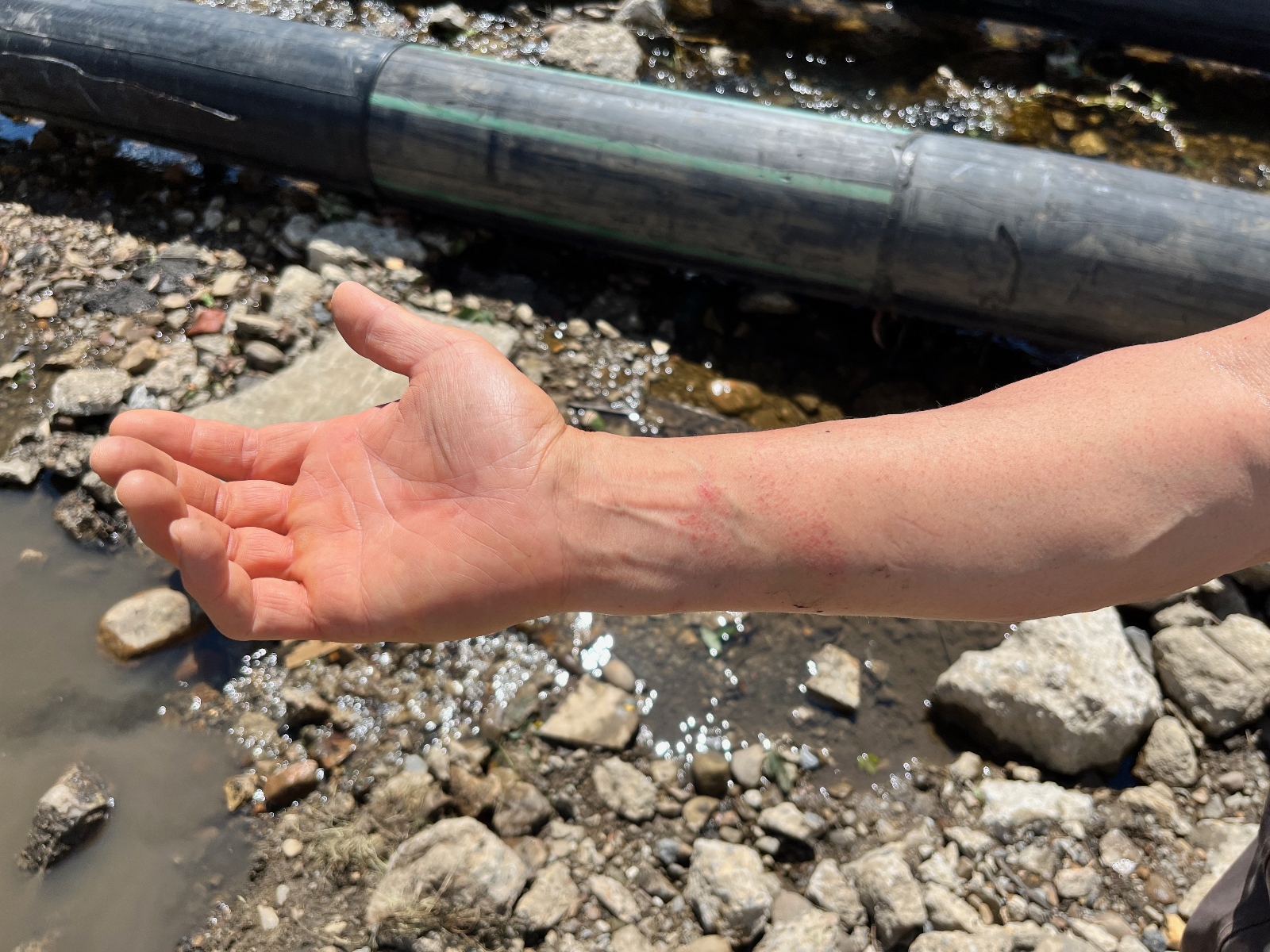
“Me getting these symptoms, proving there may be something in there, all the bullshit — why would we have to do it?” he said to me later, over the phone. “It’s because we never get any straight answers from the EPA.”
Tsai got the results back from Eurofins in the middle of September. His sample showed elevated levels of three VOCs: isopropylbenzene, cyclohexane, and methylcyclohexane, all of which are related to petroleum.
It’s no secret that there’s still oil in the creeks. First of all, you can see it. But in the middle of October, the EPA published a report that detailed derailment-related compounds — benzo(a)pyrene, toluene, and acetone, among others — detected in water sampling. The agency ordered Norfolk Southern to conduct additional analysis and cleanup of creek sediment.

The EPA reports having taken over 100 million samples of soil, air, and water in and surrounding East Palestine since the night of the derailment. The crux of the agency’s argument that local homes are safe to inhabit is that derailment-related chemicals in those samples have measured below levels considered dangerous to human health since April. And if the outdoor environment has ostensibly been free of dangerous contamination for several months, said Mark Durno, the EPA emergency response coordinator for East Palestine, in an interview with Grist, there’s no scientific rationale for concerns about the air indoors.
But other scientists who have been researching East Palestine have conflicting opinions regarding how contamination has lingered — whether it has persisted in carpets and walls and foundations of homes while it’s cleared outdoors, or if disturbance of the soil and creek water during the monthslong cleaning process stirred up chemicals into the air, polluting buildings anew. Andrew Whelton, a professor of environmental engineering at Purdue University, has been conducting studies to explore those possibilities.
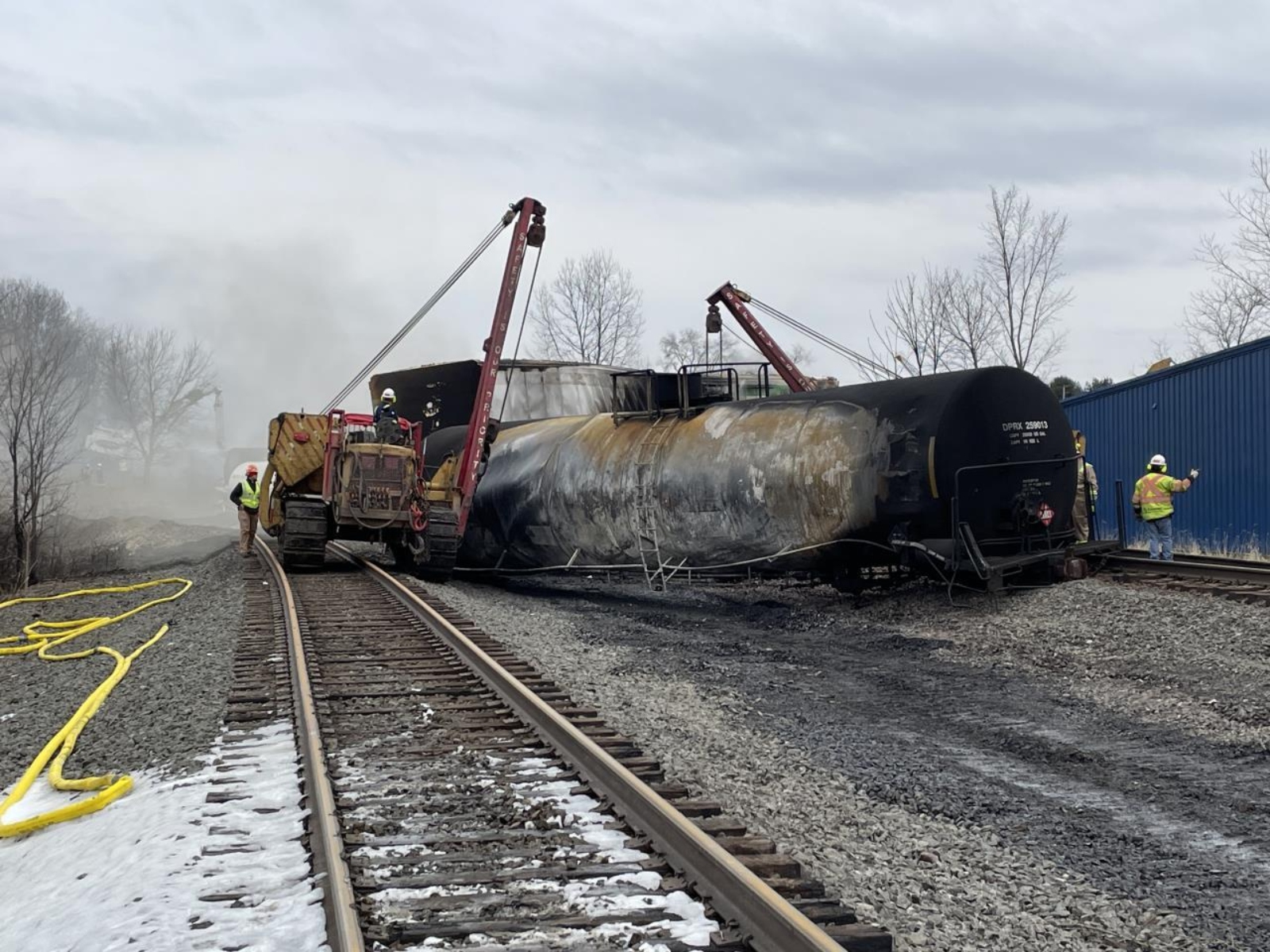
“Four months after the derailment, we went back to contaminated buildings, and they still smelled like the acrid chemical contamination odor that was associated with the spill,” said Whelton. “And after we came back to Purdue, we were contacted by several other commercial building owners around the site who said they got sick being inside within one minute. Four months after the disaster.”
That suggests, as he shared in a panel hosted by the National Academies of Science, Engineering, and Medicine, that “a number of the exposures occurred not just from the initial crash or the open burn, but the actual contamination leaving the creeks and finding its way to people either outside or inside.”
Indoor air quality is both a complicated and critical factor in post-disaster remediation. There are already a litany of chemicals from common sources — cleaning products, cigarette smoke, gas stoves — that pollute the air in a home well before a toxic explosion devastates your town. The ways in which emissions from that explosion can settle into a home and interact with each of those chemicals are also numerous and difficult to predict.
An EPA instruction guide on indoor air monitoring after an incident of contamination notes that, due to the wide variety of pathways through which a chemical can enter a building, “the amount of chemical arriving at the building then becomes a complex function of meteorological conditions and soil properties.”
There’s also debate surrounding the definition of “levels of concern,” particularly in a chemical spill with at least a dozen different pollutants mixing and intermingling with each other. Stephen Lester, cofounder of the Center for Health, Environment, and Justice in Falls Church, Virginia, has been counseling the greater East Palestine community on the risks of dioxin exposure. Lester was hired by the state of New York in 1978 as a science advisor to the community of Love Canal, where a landfill in the town of Niagara Falls leached upwards of 20,000 tons of toxic chemicals into the neighborhood surrounding it.
“Scientists and public health officials are largely making statements based on an analysis of risk of one chemical at a time,” he said. “We don’t have any analysis, any tools, or a way of judging what’s going to happen to people who are exposed to 15 chemicals.”
Almost a year has passed since the derailment and vent-and-burn. Still, residents continue to report physical ailments that they can’t explain: nosebleeds, headaches, growths, dizziness, gastrointestinal issues. (“It’s not really the stuff of polite conversation,” said one business owner in town.)
So whom do you trust? The government agency that maintains that everything is fine, or those who suggest that the danger has not fully passed?
At a town meeting a couple of weeks after the derailment, “The frustration that I was feeling in the room and hearing in the room was very much similar to the frustrations of my experiences at Love Canal,” said Lester, “where government was just openly saying one thing and people knew that just couldn’t possibly be the case, because their firsthand, personal experiences were so much different.”
And the very nature of the pollution generated by the derailment makes those personal experiences highly variable.
First, the environment in which the exposure takes place — including all the other chemicals in that environment — affects whether it has a toxic effect on a person.
“Toxic effects often add up or synergize, even if the individual chemical levels are safe,” explained Dr. Beatrice Golomb, a professor of medicine at the University of California San Diego who is conducting a study on the toxicity of the East Palestine derailment. Two people can be exposed to the same chemical — or even the same mix of chemicals — and have entirely different reactions, based on their genes and the incalculable quantity and mixture of other chemicals they’ve been exposed to in their life.
And chemicals from the spill and the subsequent burn-off seeped into the surrounding region through many different paths, concentrating around some homes while sparing others. Butyl acrylate carried down the current of the creek could settle into sediment under one house, and never touch a property far from a waterway; the cloud of incinerated vinyl chloride could rain down on one farm and blow clear over the next.
Whether you suffered or not, it seemed, was just a matter of chance.
One Halloween, when Krissy Ferguson was about 12, a bunch of neighborhood boys on Rebecca Street in East Palestine talked her into corning old man Snyder’s house. Corning, she explained, is when you fill a sock with the hard field corn that’s left after a harvest and throw it at someone’s house so that all the grains pelt against the windows like buckshot.
The way Ferguson told it on an afternoon in October, more than 30 years later, the group of them got caught and Snyder jumped on his moped and chased them down the street as if he had every intent of running them down. Terrified, she ran into the culvert under Rebecca Street, a wide stone tunnel containing a stretch of Sulphur Run. It was the first time she had set foot in it.
Many old East Palestine houses still have the remnants of century-old sewer systems, and an uncapped pipe runs directly from the Fergusons’ basement into that culvert, essentially funneling evaporation from Sulphur Run directly into her house. The creek itself rises quickly with a heavy rain, where it can flood her basement. Ferguson showed me wet patches on the concrete floor around the drain filter that tops the old pipe.
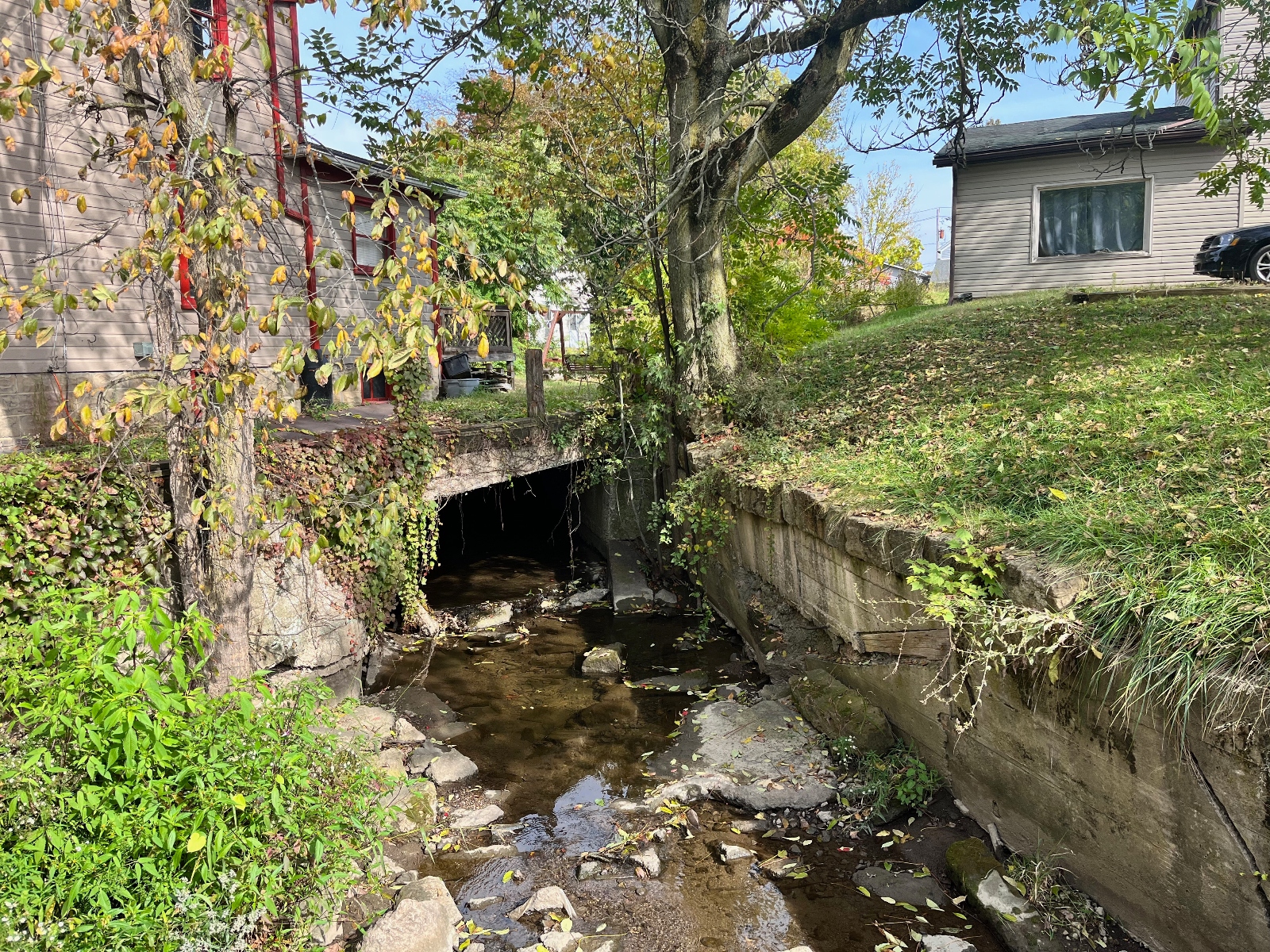
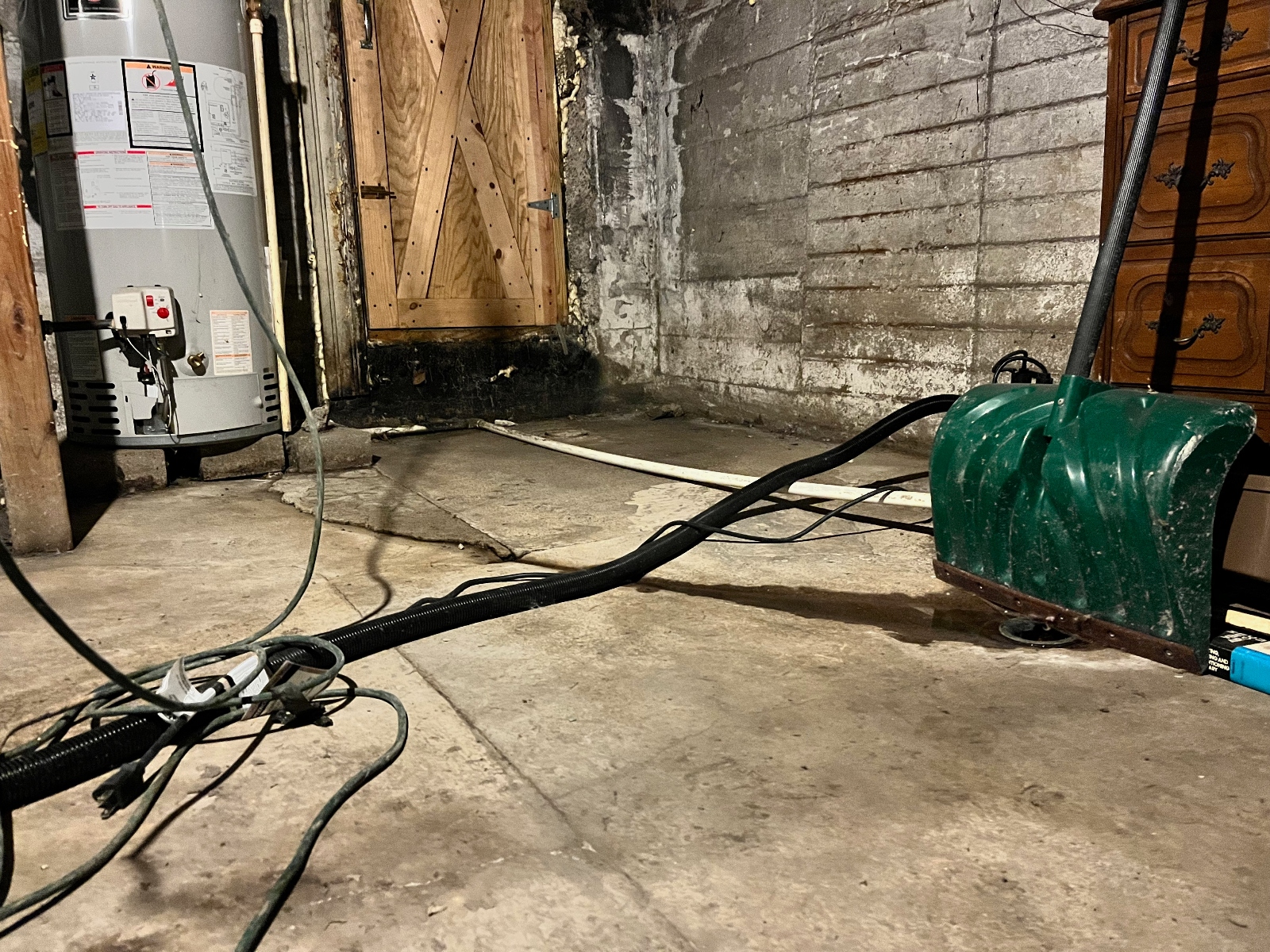
Sulphur Run flows through a culvert under Krissy Ferguson’s house on Rebecca Street. An uncapped pipe leads directly from her basement to the creek, which was contaminated in the derailment. Grist / Eve Andrews
In the days after the derailment, Ferguson felt dizzy and nauseous whenever she set foot in her house. Her eyes stung and her vision got worse. She couldn’t keep her balance walking from one end of her living room to another. The smell that permeated the house was like “sweet paint thinner” that left a strong metallic taste in her mouth and dried out her lips.
Nine months since the night the train crashed a few hundred yards from her home, Ferguson is still dealing with health complications. She suffers from headaches, her vision hasn’t fully returned, and in September, a set of growths appeared around her groin. CTEH, the emergency environmental remediation firm contracted by Norfolk Southern, has told her that everything is safe in her home, but she gets sick every time she visits.
“I can’t get out of February 3,” she said, perched on the couch in the living room she no longer lives in. “I have no more answers now than I did that night.”
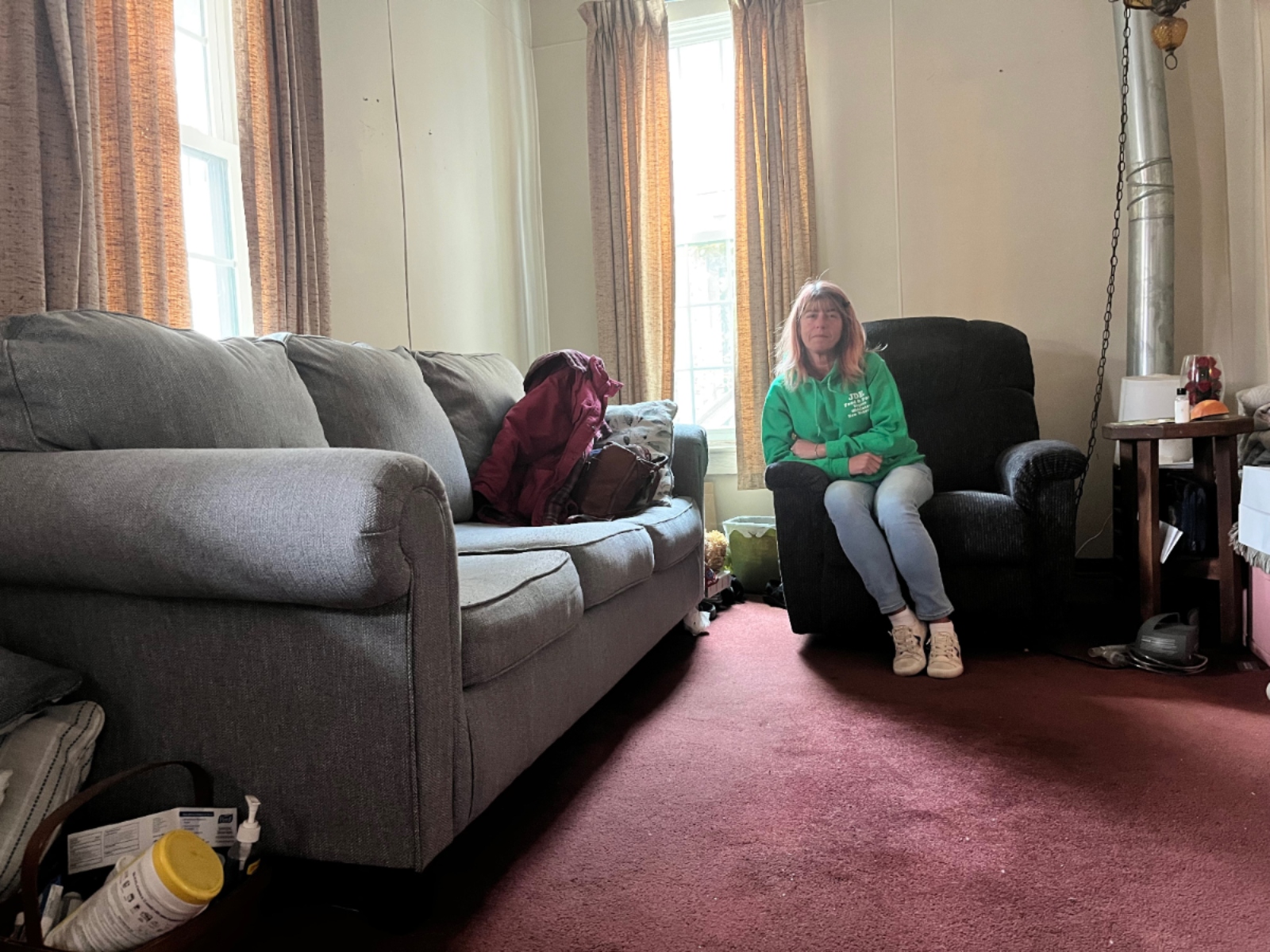
Ferguson, along with her parents, daughter, and husband, evacuated that weekend. They spent several months in two hotel rooms in the town of Chippewa, Pennsylvania, and now live in a rental house paid for by Norfolk Southern in the town of Columbiana, 15 minutes away from East Palestine.
“What I keep saying to [Norfolk Southern],” said Ferguson, “is that a pocket of chemicals sat soaking into a home built in 1930 with a sandstone foundation. You can’t get chemicals out of a sandstone foundation.”
In the vernacular of toxicology, this is what’s called “a pathway to exposure.” Jami Wallace first heard the term when a toxicologist from CTEH pointed out creek water pooling next to her basement wall, which faces Sulphur Run. (CTEH has been repeatedly criticized by environmental groups for implementing faulty data to determine health risks to the victims of environmental disasters, including the Deepwater Horizon spill. The company has responded to these accusations in the FAQ section of their website.)
He told her that any water from the creek that’s contaminated is going to emit a chemical gas as it evaporates; Wallace wanted to know who would come test the air quality in her basement every day. The next day, she said, Norfolk Southern offered to pay to move her into another home.
“So I could have kept quiet, took my little check, and left,” she said. “But that’s not the kind of people that we are, my husband or I. That night was the first town hall meeting in East Palestine, at the high school auditorium. EPA said, ‘Everything’s fine.’ Mayor said, ‘Everything’s fine.’ So I get the mic and I say, ‘Well, did you know that they said my house was contaminated and offered to move me today? I have a video of it.’ The mayor never called me back.”
For a number of East Palestine residents, the foundation of their mistrust in federal and state public health and environmental agencies comes from repeated assurances that homes showed no signs of harmful contamination, while residents like Wallace and Ferguson have received payment from Norfolk Southern for their temporary relocation — and why would they have to move if the homes weren’t contaminated? A spokesman for Norfolk Southern says that the railroad paid for relocation for those who wanted it during the cleanup process, which does not constitute an acknowledgment of contamination of those homes, and that that program would be coming to an end in February.
Testing mechanisms used by CTEH — and approved by the EPA — have also been criticized by independent scientists as insufficient, relying on inappropriate technology and thresholds of contamination higher than what is considered a risk to human health.
Whelton, the engineering professor at Purdue, said that the handheld photoionization detectors that CTEH used to measure indoor contamination in the months after the derailment weren’t sensitive enough to detect low levels of butyl acrylate and vinyl chloride that are still dangerous to human health. Furthermore, Whelton and a team of engineers conducted a study on these devices that found that they did not provide reliable readings outside of a controlled lab setting.
“We published this, we talked with the National Institute for Occupational Safety and Health seven years ago on this issue, the Centers for Disease Control 10 years ago,” said Whelton. “It was well known that these devices should not be used how they were applied.”
In June, E&E News reported that the EPA had been aware of CTEH’s use of inappropriate equipment to conduct indoor air testing for weeks before making a public statement about it. Many residents complained that they never heard about this mishap directly from the EPA, finding out about it on social media or from friends. And they never got follow-up indoor air testing, either.
An air monitoring report from CTEH for one East Palestine building, for example, found no detection of dangerous levels of VOCs on the devices used but noted a chemical odor so “unpleasant and overwhelming” that the testing team left after 10 minutes. (In response to this claim, CTEH referred Grist to its FAQ section, which reads: “While some individuals may experience psychosomatic effects from the presence of a strong odor (e.g., headache, nausea, etc.), there is a difference between that temporary, transient experience and the significant health impacts against which exposure guidelines and standards are protective.”)

In an interview, EPA emergency response coordinator Mark Durno said that butyl acrylate has such a strong odor even at extremely low concentrations that it can be detected by scent alone at levels below those considered dangerous to human health — which is why the agency is confident that that particular chemical has ventilated out of buildings, because it can no longer be smelled.
But what constitutes harmful levels of exposure in a case like East Palestine is actually very difficult to establish, because there is such a dearth of research on the health consequences of potentially continuous exposure to multiple chemicals at once.
“It’s a real indictment of the scientific community that we haven’t done the research to begin to really answer these questions,” said Lester, the toxicologist with the Center for Health, Environment, and Justice. “And it’s also an indictment of the EPA, to go before the public and say to them that everything is fine, we don’t have any evidence that your health will be affected by this.
“And that’s such a disingenuous statement, and a misstatement of reality and truth, that it’s very frustrating for someone like myself to hear that — because there’s just not data that is collected that can support it.”
Wallace and I spoke at the house she and her husband and 4-year-old daughter, Kyla, are renting in East Liverpool, Ohio, about 20 miles south of East Palestine on the Ohio River. She furnished their new home with finds culled from yard sales and thrift stores. Before moving into the hillside bungalow in May, Wallace’s family was living in hotels with little sense of how long they’d be there.
On Facebook, she noticed that many of her neighbors and contacts in East Palestine had a lot of the same questions and concerns about the EPA and Norfolk Southern’s repeated assertions that homes were safe, while the physical symptoms they were experiencing implied otherwise. She started to organize, forming a group of concerned citizens under the name Unity Council.
“It just started with us coming up with a list of demands, things like Governor Mike Dewine asking for a State of Emergency declaration, air testing, health monitoring, relocation,” said Hilary Flint, the council’s vice president. “A lot of those demands we made in that March-April time period. We’re still making the same demands.”
Flint had moved back to her family home in East Palestine’s neighboring town of Enon Valley, Pennsylvania, after a battle with cancer in 2022, and wants to know whether she’s facing exposures that could take her out of remission. In March, a research team at Wayne State University found ethylhexyl acrylate, a volatile organic compound associated with the derailment, in the air filter in Flint’s bedroom. In August, follow-up testing confirmed that the same chemical was still present in another home near Flint’s.
Continued indoor air testing is the most prevalent demand that concerned residents continue to make of the EPA. In June, members of Unity Council visited Washington, D.C. to meet with a number of congressional representatives and their staffers. That’s where they learned about the criteria for Superfund site designations.
“To go from having a number to being on the registry is a point system, and one of the ways to get the most points is if you have bad indoor air,” said Flint. “And if we went on the registry, from my understanding, they’d have to relocate a lot of people and it would possibly unlock federal benefits. I believe they’re just trying to avoid that economic burden.”
But the EPA has not offered or performed indoor testing in homes since April of 2023. In an interview, EPA emergency response coordinator Mark Durno gave several reasons for that: Testing in February and March did not show dangerous levels of derailment-related VOCs in any homes; those VOCs have short half-lifes and would be expected to ventilate out of homes by now; and the agency sees testing for the “peace of mind” of residents as not recommended due to the difficulty in distinguishing household VOCs from potentially derailment-related VOCs.
“I could see a scenario where some biological monitoring suggests that some environmental exposures that are specifically train derailment-related may be recommended,” he said. “In that case, then I could see some research dollars going towards evaluating that. But in its current condition, there’s just no feasible scientific reason to believe that there are any indoor continued exposures going on in homes.”
Misti Allison, for one, is not satisfied by those explanations. In September, she co-organized a collaboration with the local nonprofit The Way Station to distribute over 70 indoor air monitors to households across the town in homes, churches, and businesses to track VOC levels for one week. If the EPA won’t test to see if there are still toxic chemicals lingering in our homes, they said, we’ll do it ourselves.
Most of the monitors showed low levels of VOCs, but some locations scattered throughout town consistently measured in the “moderate,” “bad,” and “very bad” ranges. Allison has shared the results with the mayor, the village council, the village manager, academic researchers, and Mark Durno of the EPA.
“[Durno] was very complimentary of the community-based assessment project,” she said. “I was grateful for the support because I wasn’t sure about how the EPA would feel about us doing this citizen science.”
The problem is that these readings only tell total levels and activity of VOCs and indicate how safe that overall level is to breathe — they can’t distinguish which VOCs are present. So while residents are looking for evidence of VOCs released in the February 3 derailment, like butyl acrylate and vinyl chloride, the monitors are also picking up VOCs emitted by common household cleaners, shampoos, and other products.
Erin Haynes, chair of the department of epidemiology and environmental health at the University of Kentucky, has distributed 15 devices to append to the indoor air monitors that Allison helped distribute. Judy Westrick’s lab at Wayne State University will analyze the results from those devices to discern the presence of specific chemicals and compounds related to the train derailment, including butyl acrylate and ethylhexyl acrylate. Additionally, 20 residents of East Palestine volunteered to provide Haynes with samples of blood and urine. The blood will be analyzed by the Centers for Disease Control and Prevention for the presence of dioxins, and Westrick’s lab is measuring for a specific metabolite produced when the body processes vinyl chloride and acrylates.
The results from these tests could help answer the question of whether chemicals from the derailment have persisted in homes, months later.
“Were they exposed? Absolutely,” said Haynes. “If they were anywhere near that derailment, there was an exposure.” But the question she’s investigating is the duration of the exposure, if chemicals have lingered in indoor spaces or if pockets of chemicals in the soil and water erupted and exposed residents anew. When creeks were aerated in February and March to remove VOCs from the water, for example, there’s a possibility that those chemicals were absorbed into culverts and foundations like the one under Ferguson’s house. As of early December, the EPA was still performing cleanup in culverts across East Palestine.
In April, Beatrice Golomb, the medical professor at the University of California San Diego, launched a pilot project to analyze exposure and health effects after the derailment. Golomb previously studied the impacts of environmental pollution on veterans from the Gulf War, and found that even a few days’ worth of exposure to toxic chemicals from explosions, burn pits, and other sources of pollution can affect the mitochondria of human cells, leading to a wide and difficult-to-predict variety of health problems. When she read about symptoms being reported from East Palestine, she hypothesized that residents there might be experiencing the same thing.
“The fact that it’s multiple symptoms, spanning many different organs, that it differs from person to person — all of these are classic for impairment of mitochondria,” she said, referring to many of the reported persistent conditions.
Many residents of East Palestine and the surrounding area shared a similar feeling: that the derailment of the train on February 3 established their participation in a human experiment to which they did not consent.
“We are peeing in cups and getting arms jabbed with needles and wearing silicone wristbands to see what these long-term health care impacts are going to be, and to have real insight into what our children are facing,” said Allison. “We are truly canaries in the coal mine.”
Not everyone in town is plagued by the same level of concern. Dianna Elzer, who owns several businesses in East Palestine and the neighboring town of Negley, had well and pond water tested at several properties she and her husband own by a researcher with Wayne State University. They didn’t find anything, and she never felt sick.
“I’m in the camp that says, ‘OK, we may have some health issues down the road, but right now, we just need to kind of quit harping on it,’” said Elzer. “Norfolk Southern hasn’t left. They’re still cleaning up. EPA is still here. If they had left and it was still a mess, I’d be right there bitching with everybody else. But they’re doing a ton for this town.
“And a lot of people if you ask them — this could potentially be the best thing that ever happened to East Palestine, because we were not a thriving area. If we could survive getting to the other side, Norfolk Southern is pumping so much money into this town that it will really be a boom.”

It is a lot of money — as of press time, $104 million in addition to the $800 million cost of cleanup. A $25 million revitalization of the East Palestine City Park, courtesy of the railroad. Plans for a railroad safety training center for its employees, to bring further money and jobs East Palestine’s way. College scholarships for East Palestine high school students. More than $3 million to outfit the town’s fire department with brand-new gear. Over half a million to local nonprofits providing community aid, and another half million for an economic development consultant for the town. Air purifiers, a family assistance center on the main street of town, and a “wing bash” (as in chicken) for the town’s first responders.
But that doesn’t do much for residents who have left, too wary of lasting health impacts and distrusting of pronouncements of safety to return. And those who have stayed are increasingly frustrated by the insistence of their former neighbors that so many of the town’s homes are ruined, that the air, soil, and water are still deadly and toxic.
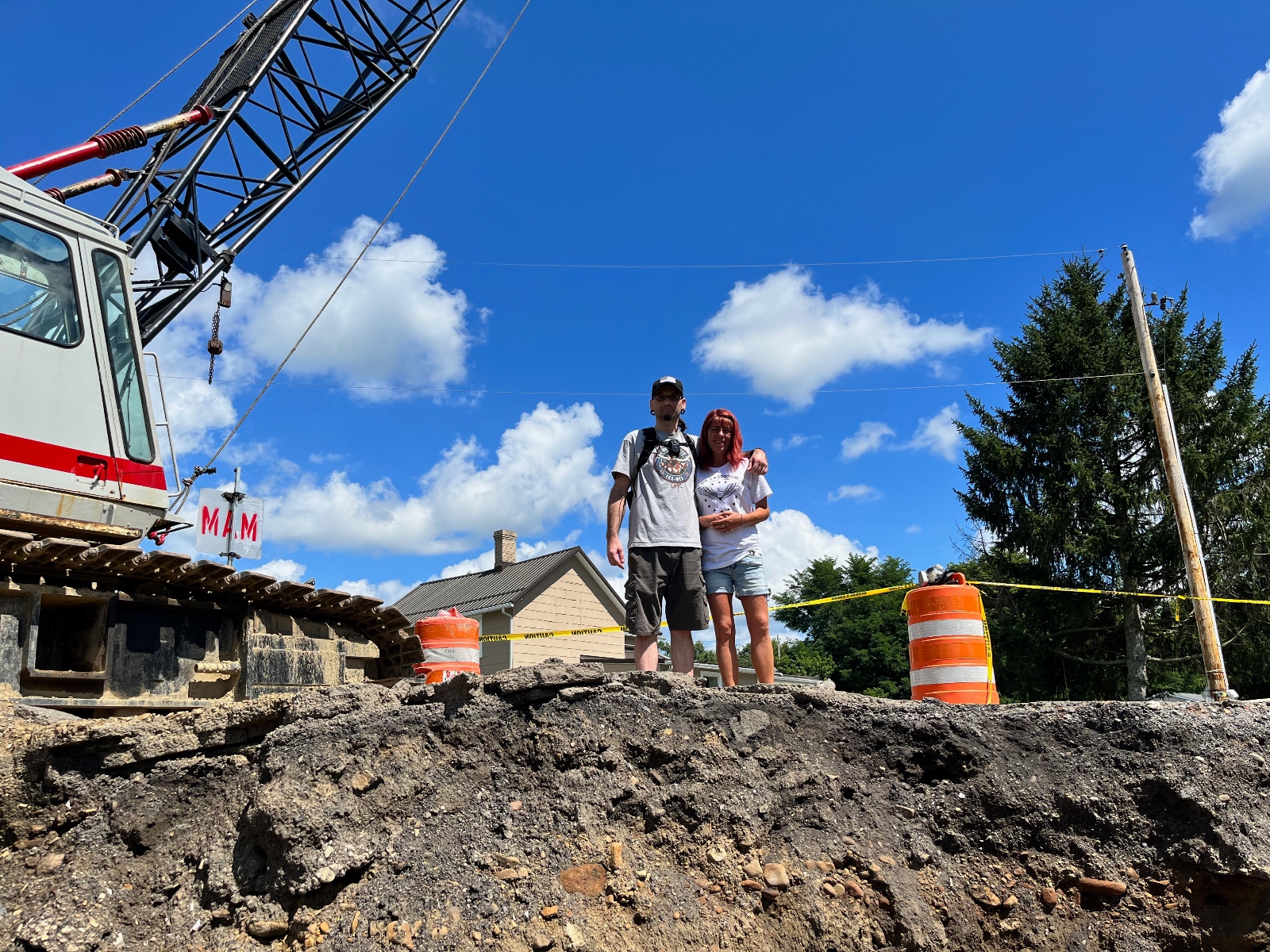
Some of Ferguson’s neighbors on her block no longer speak to her since she’s been so vocal about the possibility of lasting contamination in her home. On the day Donald Trump came to East Palestine, after Ferguson had given a number of interviews in which she’d claimed the derailment had made her home unlivable, she found a bloody severed lamb’s tongue on her porch swing. (At least, she thinks it was a lamb. It definitely belonged to a mammal.)
“A lot of us have been labeled ‘tear down the town,’” said Ferguson. “I’ve told my story. I’m not going to fight and tell anyone, ‘You’re in denial.’ Now, if you’re not experiencing [health effects], I say you’re totally blessed. Ten to 15 years from now, I hope you are as blessed as you are now. I don’t discredit them.”
The derailment in East Palestine is not the first disaster of its kind, and it won’t be the last — and those who lived through those disasters can offer advice and support to those enduring them now.
Marilyn Leistner, the last mayor of Times Beach, Missouri, before the town was evacuated due to widespread dioxin contamination from a nearby pharmaceutical manufacturer, is in frequent contact with a couple of people in East Palestine. Melissa Mays, one of the lead organizers after the Flint disaster, gave advice in the weeks following the derailment. (“She told us early on you’d see that it’d be a bunch of house mothers that were fighting,” said Wallace, “And it’s funny, because that’s almost all of Unity Council.”)
In December, Wallace began to organize the Coalition of Chemically Impacted Citizens with representatives from Times Beach, Flint, and Love Canal. “East Palestine is not gonna fight this alone,” she said. “We have a group of fighters, Flint has a group of fighters, Times Beach — if we all share information, we can accomplish a lot more. And it’s so incredibly therapeutic to talk to people who have been through this because you literally feel like you’re going insane.”
“Now that this happened to us, I’ve done more research on some of these other places,” said Daren Gamble, Jami Wallace’s stepfather who retired from his job as a bricklayer shortly before the derailment. “And, you know, it’s the same scenario over and over and over. It’s like a mass shooting, ‘Well, they don’t happen here. They happen somewhere else.’ But you know, they happen! And the bad thing is, it’s just a matter of time before it happens somewhere else, before another train derails, and we have the same thing again.”
Members of Unity Council are now connecting with communities concerned for some kind of environmental disaster coming their way. They’ve provided letters of support for a group in Cincinnati opposing the sale of one of the country’s last publicly owned railroads to Norfolk Southern; they’ve begun to consult with the nearby borough of Beaver, home of the Shell ethane cracker plant, to help them put an emergency response plan into place in the event that something goes awry at the plant.
In September, Jami Wallace, Hilary Flint, and Daren Gamble traveled to New York City for Climate Week with the organization Break Free From Plastic. It was Gamble’s first time in New York, and the group met with a number of environmental organizations to share their experiences from East Palestine.
People asked Gamble to tell his story over and over again — “not the short version, they want the whole thing.” He met Al Gore, who showed him a photo he’d saved on his cell phone from the news in February, the billowing black cloud of the explosion after the derailment. He told Gamble what was happening to his community was “criminal.”
“I probably spoke more in the last eight months than I have in 60 years,” said Gamble, sitting on the front porch of his house. “It’s just, I didn’t have anything to say. But once this started, I would talk to anybody that would listen. Maybe the right person, and you never know who, might be able to give you some help somewhere along the line.”
This story was originally published by Grist with the headline 1 year after the toxic train derailment, is East Palestine safe? Depends on whom you ask. on Jan 18, 2024.
On a windy day last August, President Joe Biden signed a proclamation protecting the canyons, cliffs, and plateaus surrounding the Grand Canyon National Park, nearly a million acres abutting the Navajo Nation and Havasupai Indian Reservation.
Biden said the new national monument was part of his commitment to Native peoples to protect their sacred lands. “Preserving the Grand Canyon as a national park was used to deny Indigenous people full access to their homelands,” Biden acknowledged.
To Carletta Tilousi, one of the leaders of the Havasupai Tribe who have called the Grand Canyon home for more than 800 years, Biden’s presence and his words felt momentous. “Finally, the small voices of Indigenous people have been heard in the White House,” she thought.
But she knew the fight was not over. The monument prevented hundreds of mining claims, but two uranium mines were grandfathered in, in part due to an 1872 law that guaranteed their right to operate. And now, nearly 40 years after first gaining permission to extract uranium, a Colorado-based company is cashing in.
On December 21, Energy Fuels Resources announced it had started mining uranium at Pinyon Plain Mine, which lies within the borders of the national monument and has lain dormant until now.
The company’s decision was influenced by favorable federal policies supporting nuclear energy, high prices for uranium ore, and greater demand for domestic nuclear fuel. The U.S. purchased 12 percent of its uranium from Russia in 2022, and there’s growing political pressure to stop those imports in the face of Russia’s war against Ukraine.
The 17-acre Pinyon Plain Mine is 12 miles from the Grand Canyon, six miles from the Grand Canyon National Park, and four miles north of Red Butte, a site sacred to the Havasupai people where Biden gave his August address. The Havasupai Tribe sued along with environmental groups to prevent the mine from starting production, but lost its case in 2022.
Energy Fuels plans to operate the mine for three years to six years and estimates that it will generate 2 million pounds of uranium, says Curtis Moore, senior vice president of marketing and corporate development.
“After mining operations are complete, the Pinyon Plain area will be fully reclaimed and returned to its natural state,” the company has promised. “There will be virtually no evidence a mine ever occupied the site.”
Amber Reimondo is doubtful. She’s energy director at the Grand Canyon Trust, a nonprofit dedicated to protecting the Grand Canyon and the Colorado Plateau that sued to prevent the mine along with the Havasupai Tribe, and says uranium mining threatens the aquifer in the greater Grand Canyon area.
“Of course we want to reduce carbon emissions, [but] we want to make sure that we do that in a way that doesn’t continue to impact Indigenous communities,” she said.
According to Reimondo, water systems in the landscape are complex and interconnected. Energy Fuels’ mining process involves drilling a mine shaft through shallow aquifers into uranium deposits, and water flows into the shaft, mixing with the ore, before being pumped out. The concern is that contaminated water will be mixed back into the groundwater.
To date, the company has removed about 49 million gallons of water from the shaft, leaving it to evaporate in an aboveground pool or sharing it with local ranchers for their cattle once treated to EPA standards. Reimondo worries that water could eventually contaminate not only drinking water sources but the creeks and waterfalls throughout the Grand Canyon.
“It’s really, really difficult for researchers to understand exactly what that risk is, because the region is so highly fractured and because we don’t know exactly where water flows to and from,” Reimondo said.
Energy Fuels’ Curtis Moore thinks that concern is overblown. He said that the water that the company pumps out of the shaft is already highly concentrated in uranium because it has been in contact with the rocks long before their mining operations started.
“Their implication is that we are contaminating groundwater, which is simply false — it’s naturally not appropriate for human consumption,” he said. He pointed to a 2022 permit from the state of Arizona that concluded the geology of the mine site — like the slope of the land and type of rock — are “expected to prevent any potential impacts to groundwater resulting from mining operations.”
A separate 2021 study by scientists from the U.S. Geological Society found that the type of uranium mining conducted at Pinyon Plain Mine has historically had no confirmed effects on uranium levels in the groundwater sampled in and around the Grand Canyon. But the study also noted that it could take many years for any related pollution to reach the groundwater.
That potential for negative long-term effects are what Havasupai Tribe members are concerned about. Dianna Uqualla, a Havasupai Tribal Council member, says if there’s pollution in the aquifer years from now, she doubts anyone will take responsibility.
“Who’s going to pay the price?” she asked. “Who’s going to be the one to say, ‘Yeah, I did it’? I don’t think anybody’s going to do that. They’re just going to say, ‘Well, one less tribe, and we’re happy for that,’ is what the non-Natives will probably think.”
Uqualla is familiar with the long history of damage wrought by uranium mining on Native lands. In the nearby Navajo Nation, years of uranium mining caused lung cancer and a decadeslong struggle to get compensation. The mining was so widely harmful that the Navajo Nation has banned the transport of radioactive and related materials through their lands.
Despite that ban, once mined, the uranium ore from Pinyon Plain Mine will be trucked to the White Mesa Mill in southern Utah along state and federal highways, including through Navajo Nation. Navajo President Buu Nygren has implored the federal government to step in on the matter.
Once the ore makes it to White Mesa Mill, the company will extract natural uranium concentrate from the uranium ore, before selling the powder to U.S. nuclear power facilities, which arrange for the concentrate to be sent to other facilities for conversion and enrichment.
Moore says that uranium mining is much safer and better regulated than it was decades ago, and trucking the uranium ore is safe. Uqualla and Tilousi remain skeptical.
Tilousi wishes that Congress would update the 1872 mining law that allowed Energy Fuels to continue operating a mine on a national monument. That’s something the Biden administration has recommended too, in part because the law allows companies to hold mining rights for long periods of time, which sows distrust among local communities including Indigenous peoples.
Tilousi is hopeful reform can happen but doesn’t expect it anytime soon.
“As a Native American living in this country, we are always fighting something,” Tilousi said. “It seems like we are always fighting for our existence.”
This story was originally published by Grist with the headline Biden protected the lands surrounding the Grand Canyon. Uranium mining is happening there anyway. on Jan 18, 2024.
Microplastics are tiny plastic particles from textiles and other sources that have broken down into smaller and smaller pieces until they are less than five millimeters in length. They have been found all over the world, from sediments in the deep ocean to Arctic snow.
Scientists have found that microplastics are being released though natural fertilizers from treated sewage sludge deposited onto agricultural fields, as more plastic particles get picked up by the wind than was previously believed, a press release from the American Chemical Society (ACS) said.
“Land application of wastewater biosolids on agricultural soils is suggested as a sustainable pathway to support the circular economy; however, this practice often enriches microplastics and associated contaminants in topsoil,” the authors of the small-scale study wrote. “Analyzing wind-borne sediments collected from wind tunnel experiments on biosolid-applied agricultural fields, we show enrichment of microplastics in wind-blown sediments.”
The researchers found that microplastics are picked up from fields by wind more easily than dust particles of a similar size.
“[T]he combined effects of the low density of microplastics and weakened wet-bonding interparticle forces between microplastics and soil particles lower their threshold velocity, the minimum wind velocity necessary for wind erosion to occur. Our calculations indicate that microplastics could be emitted at wind speeds lower than the characteristic threshold of background soil,” the researchers wrote in the study.
The study, “Preferential Emission of Microplastics from Biosolid-Applied Agricultural Soils: Field Evidence and Theoretical Framework,” was published in the journal Environmental Science & Technology Letters.
Microplastics have increasingly been found in water supplies and the human body, as well as in wastewater and sewage, ACS said. Sewage solids can be treated and turned into “biosolids” that can be used as an agricultural fertilizer that is both renewable and natural.
U.S. Environmental Protection Agency estimates are that more than 2.2 million tons of biosolids are applied to land annually — that’s approximately half the total collected in wastewater treatment plants. This gives microplastics found in biosolids the opportunity to reenter the natural environment. The tiny plastics could be carrying wastewater pollutants on them, making them dangerous to inhale.
The research team looked at wind-blown sediments containing airborne microplastics that had been gathered on two plots of land treated with biosolids in Washington state. The researchers found that the sediments had higher microplastics concentrations than the source soil or biosolids.
Because the microplastics are not as dense or “sticky” as soil minerals like quartz, they aren’t as easily trapped by moisture. This means they can more readily be swept up by breezes that are not strong enough to blow dust into the air.
“Analyzing the windspeed distribution for 3 months of wind events over a bare soil surface, we showed that more than 84% of the wind events exceed the threshold velocity of microplastics of size 150 μm, while only 23% of the wind events exceed the threshold velocity of the background soil,” the researchers wrote.
The research team said earlier models didn’t consider unique properties of microplastics like the “sticky effect” when making estimates of emissions from fields treated with biosolids. Because of this, the older models likely miscalculated the true amount of microplastics released into the air.
The team’s calculations indicated that plastic particles may be blown from barren agricultural fields almost 2.5 times more frequently by wind events than previously thought.
“Thus, current models for fugitive dust emissions may underestimate the microplastic emission potential of biosolid-amended soils,” the study said.
The post Fertilizing Fields With Sewage Sludge Releases More Microplastics Into the Air Than Previously Believed, Study Finds appeared first on EcoWatch.
Utility-scale wind and solar capacity rose by 20 percent in Southeast Asia last year, as the region comprising the Association of Southeast Asian Nations (ASEAN) brought its total capacity to more than 28 gigawatts (GW), according to a new Global Energy Monitor (GEM) report.
The increase means the region is in a good position to comfortably meet its renewables goals ahead of schedule, a press release from GEM said.
“The growth of renewables across the region is impressive, but so much more can be achieved,” said GEM researcher Janna Smith in the press release.
The report found that a difficult regulatory environment for renewable energy, lack of progress with starting new renewables projects and perpetuating reliance on fossil fuels were presenting challenges to the clean energy transition.
The figures were taken from Wind Power and Global Solar Tracker data.
Vietnam topped the region’s operating utility-scale wind and solar capacity with 19 GW, while the Philippines and Thailand each had 3 GW. Prospective wind and solar in Vietnam and the Philippeans was at 86 and 90 GW, respectively — 80 percent of the total for the region.
The ASEAN region has nearly five times the proposed offshore wind power — 124 GW — than it does onshore wind. That is almost two times the current 69 GW global operating capacity for offshore wind.
However, just a small portion of construction on prospective projects has started — 6 GW, or three percent — a quarter of the average worldwide.
The goal of ASEAN nations is to have 35 percent renewables capacity installed by 2025, so they need just 10.7 GW in addition to projects currently under construction to meet their target. The region has 23 GW in place to start up by next year, so it is in a good position to exceed its goal.
Southeast Asia has some of the fastest growing economies in the world, and is relying on renewables to ensure its energy security, reported CNBC last year.
“Overall, the region’s policies and trends show countries are eager to transition to clean energy,” said Zulfikar Yurnaidi, energy modeling and policy planning manager at the ASEAN Center for Energy, as CNBC reported.
The region’s energy demand has grown by three percent on average annually in the last 20 years, a pattern that will hold until the end of the decade, the International Energy Agency said.
“With the world now aiming to triple renewables capacity by 2030, governments need to make it easier to bring wind and solar power online. Switching to renewables now from coal and gas will save countries time and money on the path to a clean energy future,” Smith said in the press release.
The post Wind and Solar Capacity in Southeast Asia Rose by 20% in 2023 appeared first on EcoWatch.
Rental car company Hertz is selling off 20,000 of electric vehicles in its fleet, with plans to replace these vehicles with internal combustion engine vehicles.
The company cited high repair expenses and low demand as its reasons to sell the EVs, Utility Dive reported.
However, in 2021, Hertz had committed to offering one of the largest rental EV fleets in the world, stating at the time that as “consumer interest in electric vehicles (EV) skyrockets,” the company was planning to purchase more EVs, including 100,000 Teslas.
In April 2022, the company said it would buy 65,000 EVs from Polestar over the subsequent 5 years, CNN reported. Then, in September 2022, Hertz announced similar plans to buy an additional 175,000 EVs from GM, including electric models from Chevrolet, Cadillac and Buick, over the following 5 years.
But a new filing with the U.S. Securities and Exchange Commission from January 11, 2024 revealed that Hertz is looking to offload 20,000, or about one-third, of its EVs. The report noted that Hertz was expecting to use some of the money from the EV sales to purchase more internal combustion engine vehicles.
“The Company expects this action to better balance supply against expected demand of EVs. This will position the Company to eliminate a disproportionate number of lower margin rentals and reduce damage expense associated with EVs,” the SEC report said.
According to the report, Hertz still plans to offer EV rentals and work toward other EV initiatives, such as expanding charging stations and working with manufacturers to lower the costs of EV repairs.
Experts are concerned about how the sale could impact the EV market as a whole, especially as the company raised concerns over the cost to maintain these vehicles.
“The larger impact of Hertz EV fire sale is the perception hit to the technology,” Karl Brauer, an analyst at used-car aggregator iSeeCars.com, told Reuters. “Mainstream consumers are already hesitant to buy an EV, and this news only supports their concerns.”
Further, some of the EVs currently being sold by Hertz are being offered at significant discounts, and experts are worried this will hurt rates across the secondhand EV market, which has already seen major declines in EV values. As Reuters reported, value in the EV market has declined over 33% from October 2022 to 2023.
At the time of writing, Hertz has over 600 EVs for sale, over 560 of which are Teslas. But Hertz CEO Stephen Scherr told CNBC that although the demand is currently not there for Tesla and other EV rentals, that demand could increase in the future.
“The reality of EVs and Teslas being the best-selling car will, at some point, render them the best rental car,” Scherr told CNBC. “It’s not yet, so we may have been ahead of ourselves in the context of how quickly that will happen, but that will happen.”
The post Hertz Begins Selling Off EVs, Plans to Buy Gas Vehicles as Replacements appeared first on EcoWatch.

Contractors at the Salvaged Materials Market ignored the stack of misshapen supplies, but Carmelo saw the makings of his masterpiece in that pile. The sculptor spent an hour scrounging to gather all he needed, then pushed his cart of discarded treasures out the door.
Every footstep fed his mind as they led to a four-story makerspace graffitied in the mismatched styles of his community’s cultures. Carmelo floated to his curtained-off corner, spilled his haul, and began to pick and place parts on his piece-in-progress in a dance that brought his dream from the dark of mind into the studio light.
— a drabble by Syris Valentine
We tend to think of buildings as semipermanent structures. Once they go up, decades or even centuries pass before they come down. But when they do, it’s usually under the weight of wrecking balls and sledgehammers. The shattered remains of the structures that once sheltered us are then often cast into a landfill. Each year, nearly 150 million tons of this debris piles up in dumps in the U.S. alone.
Globally, the act of erecting new buildings and tearing down old ones consumes roughly a third of all resources extracted from the environment every year and produces just under a third of all the world’s waste. But several cities across the U.S. have begun to push the construction sector toward practices that keep materials out of the landfill. The goal: Reuse parts of old buildings in new ones, and recycle the rest.
In 2016, Portland, Oregon, became the first city in the country to institute a deconstruction ordinance, requiring that all single-family homes built before 1940 and slated for removal be deconstructed — that is, taken apart board by board — so their materials can be salvaged for reuse. Since then, more than half a dozen cities from San Antonio to Pittsburgh have followed Portland’s example.
“Ideally, what is being pulled out of these houses is being used for their same purpose,” says Stephanie Phillips, San Antonio’s deconstruction and circular economy program manager. Like Portland’s, San Antonio’s 2022 ordinance specifically mandates that old, historic homes be deconstructed if they’re coming down.
That’s at least in part because the best, and sometimes only, way to get the right materials to rehab historic buildings is from a different home built in the same period. As Phillips says, “Rehabbing buildings is looked at as the pinnacle of climate-wise building.”

Contractors at work deconstructing a home as part of a training in San Antonio in late 2022. City of San Antonio Office of Historic Preservation
A small number of cities go even further. Boulder, Colorado, is one of only two cities nationwide (the other being Palo Alto, California) that requires deconstruction of any and every building slated to come down, regardless of age and whether it’s residential or commercial. Boulder’s ordinance also includes what’s known as a “mandatory minimum.” At least 75 percent of the total weight of a building must be diverted from landfill through either reuse or recycling.
![]()
Jackie Kirouac-Fram, executive director of the Portland-based nonprofit ReBuilding Center, believes that a mandatory minimum is necessary to achieve the intent of these deconstruction ordinances: salvaging high-quality materials that homeowners, builders, and craftspeople can then access at affordable rates. Without this requirement, Kirouac-Fram says, Portland has seen particularly low rates of salvage. (Official figures aren’t available, and city representatives didn’t respond to a request for comment.)
While San Antonio also lacks a mandatory minimum, Phillips says the city’s contractors have on average recovered 70 percent of a given building’s weight, with over half of the recovered materials going to reuse. Phillips attributes these figures to the thorough, city-sponsored training contractors must go through in order to qualify for San Antonio’s list of certified deconstruction contractors.

Lumber, bricks, doors, and other reclaimed materials are piled on the side of a deconstruction training site in San Antonio. City of San Antonio Office of Historic Preservation
Meanwhile, in Boulder, despite its mandatory minimum, the city has not provided much training for the local workforce or established certification requirements, according to Emily Freeman, the city’s policy advisor on the circular economy. As a result, some contractors may exploit loopholes to meet the requirements without salvaging so much as a single two-by-four, and property owners have few tools to evaluate the bids they receive. They’re being asked to compare “apples to kiwis,” Freeman says.
In the worst example she has seen to date, a contractor used the foundation — the heaviest part of a building — as well as patio furniture and mulched trees on the property to meet the requirement to divert 75 percent of the building’s weight.
This reveals another challenge when it comes to mandatory minimums: Such requirements often don’t differentiate between reuse — the ideal form of waste diversion — and recycling. For instance, if lumber isn’t sorted and stored so it can later be picked up and incorporated into a new project, it might instead be sent through a chipper and processed into particleboard.
To address these problems, Freeman and her colleagues are looking to revise and strengthen some of Boulder’s deconstruction practices, which could include hosting trainings and establishing a certified contractors list, similar to San Antonio’s, to ensure everyone has the same playbook of best practices. Freeman hopes that these types of changes would help Boulder to achieve the vision she briefly saw realized in 2023, when the city deconstructed an abandoned hospital. Of the 65-million-pound building, the city recycled or salvaged 60.8 million pounds, or 93.5 percent of the building’s weight. This included structural steel that has found its way into two new city-owned buildings: a fire station and a golf course clubhouse.
![]()
Taking salvaged materials and getting them into other buildings is what organizations like Kirouac-Fram’s ReBuilding Center aim to facilitate. It stores salvaged materials that Portlanders can purchase at low-to-no cost. San Antonio has launched its own Material Innovation Center to find the next best use for salvaged materials, including bus shelters, garden beds, and affordable housing repairs.
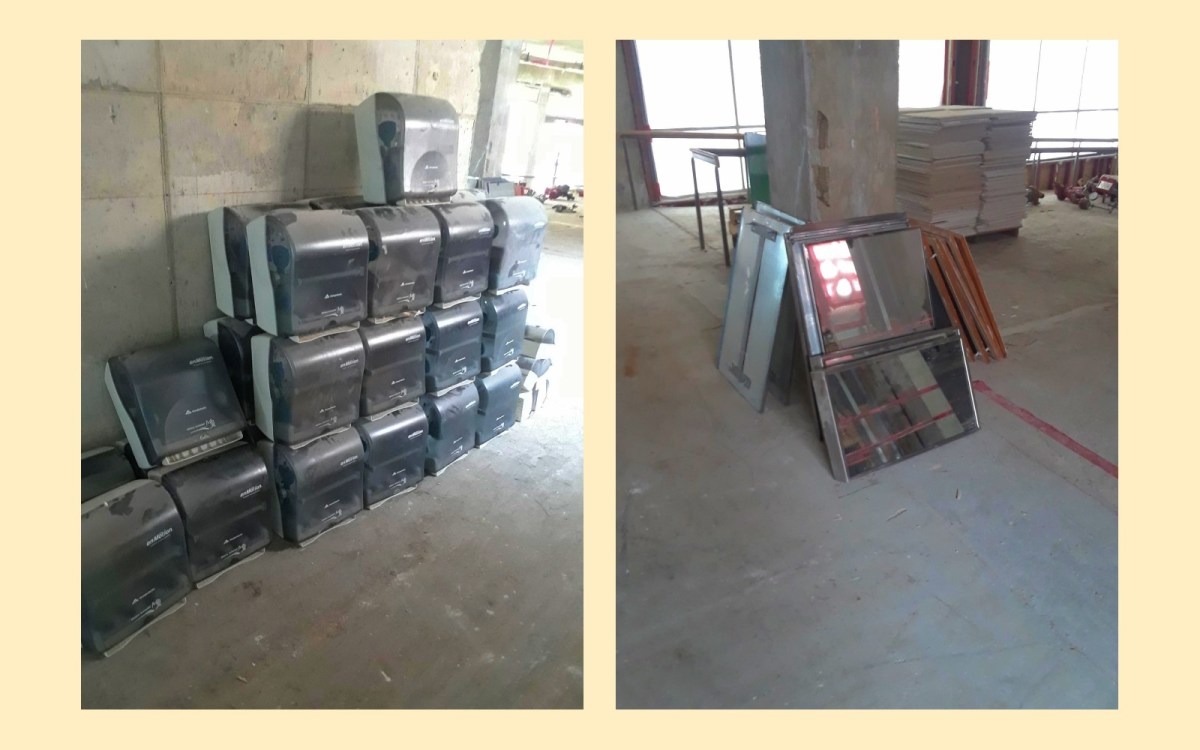
Paper towel dispensers and mirrors are gathered inside the abandoned Boulder hospital during its deconstruction. City of Boulder
But a final challenge remains in many of these cities: getting contractors to use salvaged materials in their projects. In some cases, the problem is a matter of ease and inventory; contractors don’t want to waste time browsing stacks of mismatched materials when they may not find what they need. In other cases, builders still need to be convinced that giving old materials a second life in new construction won’t compromise a building’s integrity.
Boulder has been struggling to close this piece of the reuse loop. Though the city has incorporated many of the metal beams extracted from the old hospital into new city-owned properties, some leftover steel remains. City officials are still in talks with builders in Boulder to find someone to take what’s left.
“It’s just a matter of convincing the construction world that reused steel is going to be solid,” Freeman says. She hopes that as people see other buildings standing strong with salvaged steel, they’ll start to use it in projects of their own.
— Syris Valentine
Habitat for Humanity, the affordable housing organization, sells used home goods at its ReStores. Shoppers can find more than just furniture — the stores often stock building supplies like doors and windows, and even toilets, sinks, and tubs. Here, volunteers arrange plumbing supplies (including a gigantic tub) in a store that opened in 2006 in Portland, Maine.
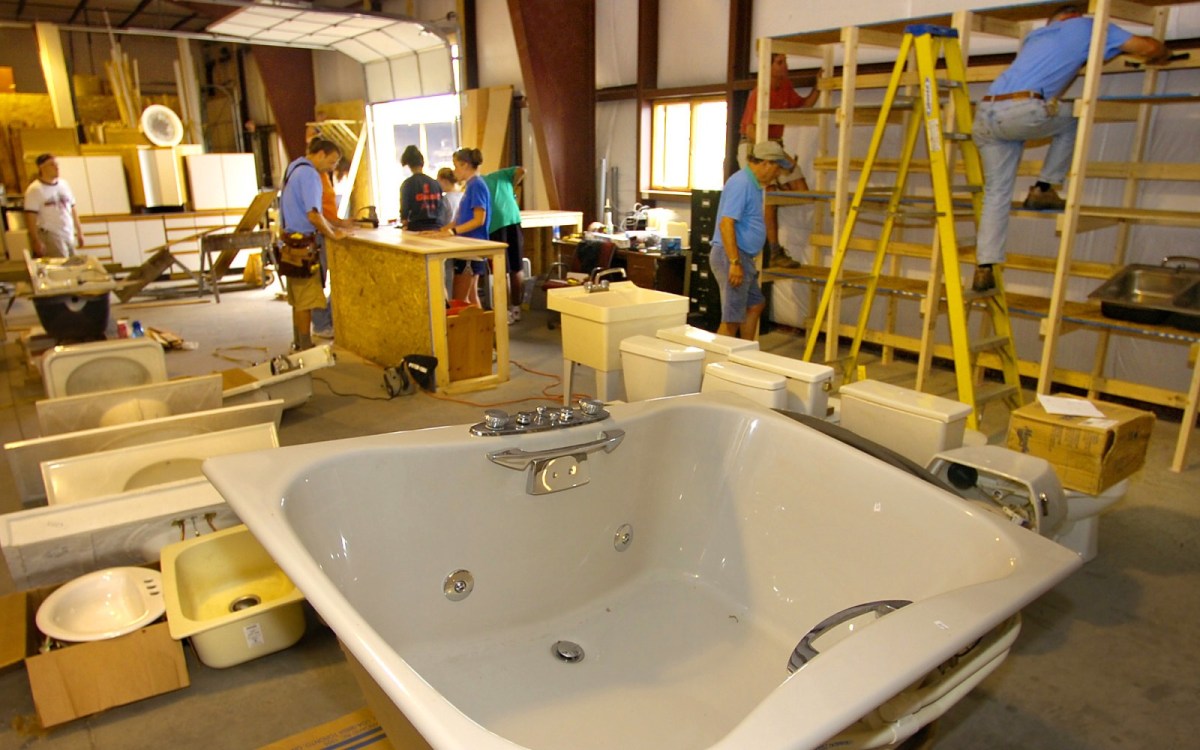
This story was originally published by Grist with the headline To keep building materials out of landfills, cities are embracing ‘deconstruction’ on Jan 17, 2024.
The rise of electric and plug-in hybrid vehicles will require a transformation in battery technology,…
The post Best of Earth911 Podcast: Guidehouse Insights’ Sam Abuelsamid Maps the Future of EV Battery Innovation appeared first on Earth911.
An ebike is the most efficient way to travel and reduce your climate impact. With more than 300…
The post How To Recycle eBike Batteries appeared first on Earth911.
For decades, environmental advocates have been pushing back against “greenwashing,” when polluting companies misleadingly present themselves as environmentally friendly. Governments are finally starting to tackle the problem with stricter regulations: The European Union agreed to ban deceptive environmental ads in September, and the U.S. Fair Trade Commission is in the process of updating its guidelines around green advertising.
But as new rules go into effect, they’re contributing to a different problem: Many companies, even honest ones, are afraid to talk about their work on climate change at all.
The practice of “greenhushing” is now widespread, according to a new report released on Tuesday by South Pole, a Switzerland-based climate consultancy and carbon offset developer. Some 70 percent of sustainability-minded companies around the world are deliberately hiding their climate goals to comply with new regulations and avoid public scrutiny. That’s in contrast to just a few years ago, when headlines were full of splashy corporate promises on climate change and even oil companies were pledging to zero out their emissions. The report suggests that this newfound silence could impede genuine progress on climate change and decrease pressure on the big emitters that are already lagging behind.
South Pole found that climate-conscious companies in fashion, consumer goods, tech, oil, and even environmental services are “greenhushing.” Nearly half of sustainability representatives reported that communicating about their climate targets has become harder in just the past year. But companies aren’t giving up on going net-zero — just the opposite. Of the 1,400 companies surveyed, three-quarters said they were pouring more money than before into efforts to cut carbon emissions. They just didn’t want to talk much about it.
“We really just cannot afford to not learn from each other,” said Nadia Kähkönen, a deputy director at South Pole and the report’s lead author. Companies should be sharing the lessons they’ve learned from trying to cut their emissions, engaging one another in hard conversations about “what is working and what is not, and how we can improve it,” she said.
Greenhushing was the most common, unexpectedly, among the greenest companies. Some 88 percent of those in environmental services, a category that includes renewables and recycling, said they were decreasing their messaging about their climate targets, even though 93 percent said they were on track to meet their goals. Consumer goods companies, like those that sell food, beverages, and household goods, were the next likely to be greenhushing (86 percent), more than the oil and gas industry (72 percent).
The survey, conducted anonymously, is the first to offer insight from companies as to why they’re keeping quiet. Environmental service companies had one of the same top reasons as oil companies: heightened scrutiny from investors, customers, and the media. Among all the companies that admitted to greenhushing, well over half listed changing regulations as a reason why they’re not talking about their climate pledges. Some companies also cited a lack of sufficient data or clear industry guidance around how to communicate their green claims.
Their hesitation has real consequences, researchers from South Pole said. For one, it cuts down on the sense of competition and pressure that can drive companies to be more ambitious with their environmental targets. “If you’re hiding what you’re doing, or not talking about it in a prominent way, it can hold back others,” said George Favaloro, South Pole’s head of climate solutions for North America. The trend also could also cut down on sharing tips and tricks for decarbonizing that could help others trim their carbon emissions.
The report found that greenhushing isn’t unfolding equally across the 12 countries surveyed. American companies aren’t as quiet — likely because the United States has less regulation around environmental claims. U.S. companies were the second least likely to be greenhushing, behind Japan. European companies were on the opposite end of the scale. France, which has laws that explicitly limit greenwashing, led the pack with 82 percent of companies staying mum.
“They’re really up against it in Europe now, and in the U.S., it’s still a bit off in the future,” Favaloro said. “It’s coming, but it’s not quite here yet.” One of the first anti-greenwashing laws in the U.S. went into effect in California earlier this month, mandating that large companies disclose their emissions to back up climate-friendly claims. Lawsuits are also a growing threat: Last year, Nike and Delta Air Lines were sued for making questionable claims about their environmental impacts.
It might be surprising that U.S. companies are unafraid of communicating their climate goals considering the conservative backlash against ESG, short for “environmental, social, and governance,” a set of standards investors use to assess companies. But the ESG drama has more serious consequences for asset managers like Vanguard and BlackRock, which removed references to sustainability goals on their websites last year, than for corporations.
The 1,400 companies surveyed in the South Pole report are some of the furthest along when it comes to corporate climate action. Overall, however, most companies haven’t even started yet. Only 8 percent of a broad group of 77,000 corporations, which includes global Fortune 500 companies, have set a net-zero target, the report found. “The more that even the leaders don’t talk about what they’re doing, it’s going to provide less motivation to get that group in the game,” Favaloro said.
This story was originally published by Grist with the headline Companies are hiding their climate progress. A new report explains why. on Jan 17, 2024.